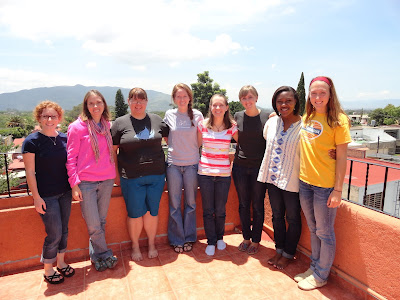We won't all be teaching ESL each week in Oaxaca, but I am grateful for the knowledge she shared with us. Some of it is applicable to any situation in which we may be in teaching positions, and it will also be useful for future ESL opportunities we may have in the States.
Jenny, one of our supervisors, drew a picture of the day's activities for our visual learners...pizza was an important part of the day! We have come to treasure pizza here because it is one meal that pretty much tastes the same as in the U.S. and reminds us all of home.
Kat and I in our first ride in a Colectivo, which is a car that functions as a bus in that it follows the same route through the city. We are finally learning our way around the city using public transportation!
Friday evening we had the opportunity to attend an event in one of the villages nearby. We were warmly welcomed! As soon as we arrived we were taken to a table for dinner where we ate Barbacoa...Lamb! Another first for most of us! Lamb is a special meal here usually served on important occasions or at special events. Our field contact pointed out that the preparations for the meal probably took all day and began early that morning with live sheep going "baa". Talk about fresh meat!
Where the sweet ladies cooked all day!
Saturday morning we went to a lady's house in a nearby village where she taught us how to make tortillas! It was such a fun experience! This is the fire pit. The metal pan on top is called a comal.
This is a picture of the dough which is called masa. The ladies take the corn kernels in baskets on top of their heads to a place where they grind the corn and make it into this dough. They knead it out on a large stone and use portions of it to make the actual tortillas.
They place the dough between two pieces of plastic (usually bags from a store that they cut up), and then use a press to flatten the dough.
Once the dough is the right thickness, the plastic is peeled off of each side carefully so the dough doesn't tear.
The dough is then placed on the comal for a few minutes and flipped periodically.
I had so much fun learning this process and our friend even invited me to stay in their village and help make tortillas. And check out the cute aprons! All the ladies from the indigenous villages we've seen wear these.
This family usually makes about 20-25 tortillas every other day.
Isn't she precious!?!
This is a cradle they have rigged together so that the ladies can watch after their babies while they cook tortillas. I love their thriftiness!
The group with our maestra (teacher).
After our Tortilla class, we helped teach ESL to some kids in one of the villages. They have been learning about body parts.
Saturday evening we had some free time so we went downtown and strolled down the walking street, a street blocked off to cars and for pedestrian use only.
It has been a great week and I feel blessed that the Lord has given me the opportunity to call this beautiful place home for the next few months.
"The heavens declare the glory of God, and the sky above proclaims his handiwork." Psalm 19:1






















I have so many thoughts right now! I find it interesting how Mexicans and Guatemalans make tortillas differently, but there were some similarities as well. (same same, but different) :-) Did you see any of the women not using the dohicky thing to make the tortillas, but using their hands?
ReplyDeleteThose aprons looked so cute! I can see you rockin one of those when you get back. :)
Miss you tons!!
Sarah,
ReplyDeleteCatching up on your experience. Sounds like you are enjoying it. We miss you.
Prayers and blessings,
Sr. Priscilla